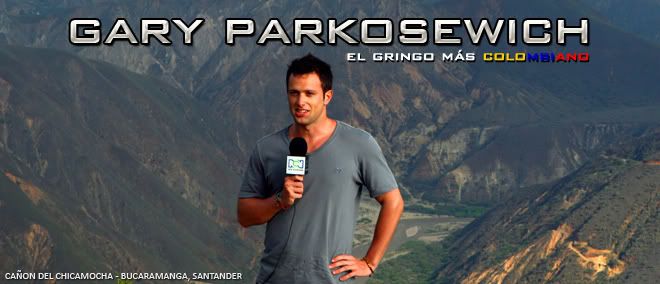skip to main |
skip to sidebar
 My return to Medellín, of course, was inevitable. After all, it was the first city I ever visited in Colombia and the one city that inspired me to ultimately change my entire life; and for that, I will always carry Medellín in a special place in my heart.
My return to Medellín, of course, was inevitable. After all, it was the first city I ever visited in Colombia and the one city that inspired me to ultimately change my entire life; and for that, I will always carry Medellín in a special place in my heart.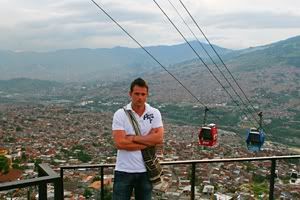 Although my home now is Bogotá, I will always feel a stronger connection to Medellín for those reasons. People even say I speak Spanish as if I learned it in Medellín. Apparently it's is an odd combination of gringo and paisa. I guess it's because I've always found the paisa (Medellín) accent easier to imitate than a rolo (Bogotá) accent, even though rolos insist they speak the better Spanish. Paisas however couldn't disagree less.I arrived to the "City of Eternal Spring" on August 5 to cover the Fería de las Flores (Flower Fair) running around like a chicken with its head cut off – making stories, writing scripts on my BlackBerry, tracking them, locating the RCN satellite truck to send it back to Bogotá, and of course fighting heavy holiday traffic.
Although my home now is Bogotá, I will always feel a stronger connection to Medellín for those reasons. People even say I speak Spanish as if I learned it in Medellín. Apparently it's is an odd combination of gringo and paisa. I guess it's because I've always found the paisa (Medellín) accent easier to imitate than a rolo (Bogotá) accent, even though rolos insist they speak the better Spanish. Paisas however couldn't disagree less.I arrived to the "City of Eternal Spring" on August 5 to cover the Fería de las Flores (Flower Fair) running around like a chicken with its head cut off – making stories, writing scripts on my BlackBerry, tracking them, locating the RCN satellite truck to send it back to Bogotá, and of course fighting heavy holiday traffic.
 Once the stuff was sent, I had to call my producers and instruct them how I wanted the story to be done, hoping they would understand me with loud salsa music booming in the background of Parque Norte.
Once the stuff was sent, I had to call my producers and instruct them how I wanted the story to be done, hoping they would understand me with loud salsa music booming in the background of Parque Norte.
It was all a rush but I felt very proud I was able to accomplish this, and I wouldn't mind doing it at all again.
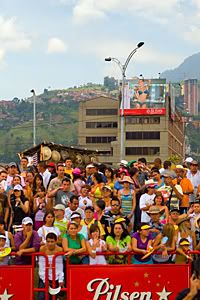 On my trip, I met Medellín Mayor Alonso Salaso and climbed to the top of the Mayor's Office, getting a perfect 360° view of the city. I also visited Medellín's usual tourist sites including Pueblito Paisa where I sang "Ay Hombe" by vallenato singer Jorge Celedón in front of a large crowd. I don't have the "Factor X" however.
On my trip, I met Medellín Mayor Alonso Salaso and climbed to the top of the Mayor's Office, getting a perfect 360° view of the city. I also visited Medellín's usual tourist sites including Pueblito Paisa where I sang "Ay Hombe" by vallenato singer Jorge Celedón in front of a large crowd. I don't have the "Factor X" however.
Once I was done with my stories around at 8:00 PM, I could do whatever I wanted, so I ended-up taking a long taxi ride over to the northwest part of the city to visit some friends. It was the first time I had seen them in seven months so we were both all happy to see each other again.My best experience covering the feria was the ever famous "Silletero" parade, the main event of the Feria de las Flores where enormous flower displays – called silletas – are carried through the streets. Army helicopters flew over the parade, dropping bushels of flower petals onto the crowd, as if it were raining petals from the sky.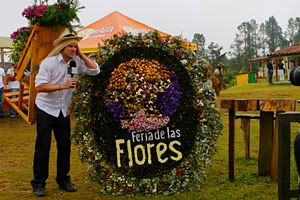 After making my stand-ups for my package, my cameraman and I walked through the parade itself. It shocked me how many people recognized me as the "RCN gringo." Several asked for my picture or autograph while people who didn't know me soon learned who I was.It's such an amazing feeling when you walk through miles and miles of people and have them all cheer for you. Not just small cheers but loud, roaring cheers, booming through the parade as if I were a soccer player running onto a field. One person who spoke English came up to me telling me what an amazing impact I was having on Colombia.Nothing felt better than knowing I captivated the hearts and minds of the Paisas; and I can't thank them enough for always renewing my love for Colombia and reminding me why their country is truly great. As my Medellín friends – my parceros – say, "Medellín es una chimba!"
After making my stand-ups for my package, my cameraman and I walked through the parade itself. It shocked me how many people recognized me as the "RCN gringo." Several asked for my picture or autograph while people who didn't know me soon learned who I was.It's such an amazing feeling when you walk through miles and miles of people and have them all cheer for you. Not just small cheers but loud, roaring cheers, booming through the parade as if I were a soccer player running onto a field. One person who spoke English came up to me telling me what an amazing impact I was having on Colombia.Nothing felt better than knowing I captivated the hearts and minds of the Paisas; and I can't thank them enough for always renewing my love for Colombia and reminding me why their country is truly great. As my Medellín friends – my parceros – say, "Medellín es una chimba!"
It’s been a while, hasn’t it?
 I’ve been spending the last month traveling around Colombia, getting to know even more of this beautiful country. Cumaral, Meta; Paipa, Boyacá; Nemocón, Cogua, and Fusagasuga, Cundinamarca, and El Espinal, Tolima, just to name a few. I worked for 33 days without one day of rest, which was exhausting but I love my job and do my work with all heart and dedication.
I’ve been spending the last month traveling around Colombia, getting to know even more of this beautiful country. Cumaral, Meta; Paipa, Boyacá; Nemocón, Cogua, and Fusagasuga, Cundinamarca, and El Espinal, Tolima, just to name a few. I worked for 33 days without one day of rest, which was exhausting but I love my job and do my work with all heart and dedication.
One thing I will say about Colombia is I have yet to find a city or town that is ugly. Every region in this country has its own unique appearance and all of them beautiful in their own way. I also notice that every one of these municipalities has a strong sense of pride in itself. Anytime I visit a place with the RCN crew, the mayor and townspeople always makes sure we’re having a good time and enjoying their home.
 In my travels I've also had the pleasure of meeting more Colombian celebrities. Los Gigantes del Vallenato, Nelson Velásquez, Peter Manjarres, just the name a few. All three, of course, are an honored part of my vallenato collection.
In my travels I've also had the pleasure of meeting more Colombian celebrities. Los Gigantes del Vallenato, Nelson Velásquez, Peter Manjarres, just the name a few. All three, of course, are an honored part of my vallenato collection.
More and more people are starting to recognize me on the street as "that gringo from RCN" and ask for my picture or autograph. My name, however, is still too complicated for many Colombians to pronounce but I know they'll get there someday. Moving on, the first trip in my long list of recent travels was CUMARAL, META. Meta is always a treat because of the hot weather; a great escape from the generally mild climate of Bogotá. Mamona, a favorite dish of the Llanos region, is by far the juiciest, freshest, most delectable meat you’ll ever sample, while the sound of joropo music always puts you in a deep, pensive mood. It’s the perfect “driving music” when traveling from one point of Colombia to another.
Moving on, the first trip in my long list of recent travels was CUMARAL, META. Meta is always a treat because of the hot weather; a great escape from the generally mild climate of Bogotá. Mamona, a favorite dish of the Llanos region, is by far the juiciest, freshest, most delectable meat you’ll ever sample, while the sound of joropo music always puts you in a deep, pensive mood. It’s the perfect “driving music” when traveling from one point of Colombia to another.
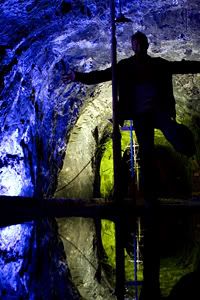 My second trip was to COGUA and NEMOCÓN, CUNDINAMARCA, both cooler than the capital city in terms of climate, but the incredible, surrounding green mountains make up for what the towns lack in warm weather.
My second trip was to COGUA and NEMOCÓN, CUNDINAMARCA, both cooler than the capital city in terms of climate, but the incredible, surrounding green mountains make up for what the towns lack in warm weather.
The salt mine in Nemocón, Cundinamarca is one of the most amazing spots you’ll ever see above or below ground. When you first think of salt, nothing special comes to mind except for the stuff you sprinkle on French fries. But when you’re at its source, 60-80 meters beneath the Earth, you immerse yourself among a collection of the world’s most underappreciated gems.
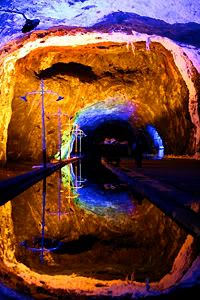 Dispersed throughout the tunnels are arrays of multicolored lights and decorations. Put these and immense walls of salt together and you will discover nature’s abstract masterpiece: vaults of enormous, chiseled blocks of vivid, colorfully psychedelic crystals. It all looks like candy but lick the sides and you’ll realize it’s still pure salt.
Dispersed throughout the tunnels are arrays of multicolored lights and decorations. Put these and immense walls of salt together and you will discover nature’s abstract masterpiece: vaults of enormous, chiseled blocks of vivid, colorfully psychedelic crystals. It all looks like candy but lick the sides and you’ll realize it’s still pure salt.
The mine’s little lakes and streams in one of caverns create reflections of the ceiling so sharp, so pristine, you initially think you’re staring down a cliff meters below your feet. (check out the picture on the left) I didn’t realize the truth until my tour guide, Orlando, told me I was really staring at super saturated salt water. It’s nature’s most amazing optical illusion and the reason why Nemoconenses call it, “the magic room.”
I don’t think I’ll ever look at a saltshaker the same again.
PAIPA, BOYACÁ was another small town but nevertheless memorable. The Sochagota Lake (seen in the above picture) was an amazing site because not only can you look at the water but also the super green mountains in the background.
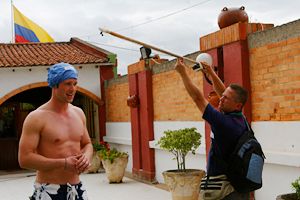 The highlight of Paipa of course was the aguas termales – a spa built around a boiling pond of water believed to be heated by an underground volcano.
The highlight of Paipa of course was the aguas termales – a spa built around a boiling pond of water believed to be heated by an underground volcano.
There were six parts to the spa including a heated pool, Jacuzzis, saunas, and thermal mud. It was one of the very few instances a television reporter could present shirtless and have a beautiful woman rub mud on his body. I remember thinking as I was making the special, “Am I really getting paid to do this?” By my final presentation, I was so relaxed my mind felt numb and I could hardly move my mouth.

And now that leaves us with my most recent trip, EL ESPINAL, TOLIMA a place much warmer than Cundinamarca and Boyacá but not nearly as hot as Barrancabermeja, Santander.
 I was there covering the Festivo de San Pedro, a big holiday celebrated all around Colombia. The department of Tolima, however, has the biggest festivities. I got a chance to see yet another beauty pageant, this time the Reinado del San Pedro. Lucky for me, I met several of the beauty queens. I know, I have a tough life sometimes. ;)
I was there covering the Festivo de San Pedro, a big holiday celebrated all around Colombia. The department of Tolima, however, has the biggest festivities. I got a chance to see yet another beauty pageant, this time the Reinado del San Pedro. Lucky for me, I met several of the beauty queens. I know, I have a tough life sometimes. ;)
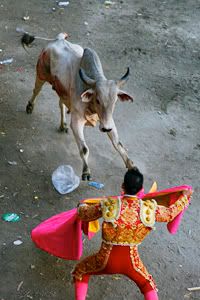 It was here in El Espinal I witnessed my first bullfight and one of the more interesting stories I’ve reported for RCN.
It was here in El Espinal I witnessed my first bullfight and one of the more interesting stories I’ve reported for RCN.
For starters, the stadium was a series of closed rooms built entirely of wood and bamboo. You had to climb a ladder in order to reach another level.
The food vendors, on the other hand, had to maneuver around the stadium clinging onto the outside ledges. One false move, and they could fall at least three meters to the ground. You can find the story here.
As for the bullfight itself, it was brutal as expected but interesting nevertheless. It was sometimes difficult watching the bulls wincing in excruciating pain but I also admired the skill and courage it takes to do one of these dangerous spectacles.
 The bulls used in the fight I was covering, however, were Brahman bulls; much less aggressive than your typical bullfighting breeds. After a few stabs in the back by the banderilleros, the bulls would either give-up and run back into their stadium quarters or sit down, refusing to move.
The bulls used in the fight I was covering, however, were Brahman bulls; much less aggressive than your typical bullfighting breeds. After a few stabs in the back by the banderilleros, the bulls would either give-up and run back into their stadium quarters or sit down, refusing to move.
Spectators were welcome to join-in on the fun too with these relatively “tame” Brahmans. It was crazier watching this huge group of people attack the bull than the crowds at soccer stadiums. The people would surround it, swat-it, lasso-it, grab its tail and once in a while get a well-deserved trampling. You can see it all in my story here.
 My favorite part of El Espinal, however, was a place called “La Caimanera,” a nice little getaway next to the Magdalena River. You can swim in Colombia’s most famous body of water, then have a picnic, eating freshly caught fish. Afterward, you grab a few drinks and dance in a huge hut, overlooking the beautiful scenery.
My favorite part of El Espinal, however, was a place called “La Caimanera,” a nice little getaway next to the Magdalena River. You can swim in Colombia’s most famous body of water, then have a picnic, eating freshly caught fish. Afterward, you grab a few drinks and dance in a huge hut, overlooking the beautiful scenery.
La Caimanera was quiet, relaxing and fun. The late afternoon sun gave the mountains and the waters of the Magdalena a crisp, golden hue as if it really were made of the precious metal itself. Plus, now that I've bathed in the Magdalena River, I think I've officially been baptized as a Colombian.
Although I was relieved to finally relax after working and traveling for so long, I have absolutely no regrets. I love my job and I love my life here in Colombia, and the more I get to know this beautiful country, the deeper I fall in love with it.
 My return to Medellín, of course, was inevitable. After all, it was the first city I ever visited in Colombia and the one city that inspired me to ultimately change my entire life; and for that, I will always carry Medellín in a special place in my heart.
My return to Medellín, of course, was inevitable. After all, it was the first city I ever visited in Colombia and the one city that inspired me to ultimately change my entire life; and for that, I will always carry Medellín in a special place in my heart. Although my home now is Bogotá, I will always feel a stronger connection to Medellín for those reasons. People even say I speak Spanish as if I learned it in Medellín. Apparently it's is an odd combination of gringo and paisa. I guess it's because I've always found the paisa (Medellín) accent easier to imitate than a rolo (Bogotá) accent, even though rolos insist they speak the better Spanish. Paisas however couldn't disagree less.
Although my home now is Bogotá, I will always feel a stronger connection to Medellín for those reasons. People even say I speak Spanish as if I learned it in Medellín. Apparently it's is an odd combination of gringo and paisa. I guess it's because I've always found the paisa (Medellín) accent easier to imitate than a rolo (Bogotá) accent, even though rolos insist they speak the better Spanish. Paisas however couldn't disagree less. Once the stuff was sent, I had to call my producers and instruct them how I wanted the story to be done, hoping they would understand me with loud salsa music booming in the background of Parque Norte.
Once the stuff was sent, I had to call my producers and instruct them how I wanted the story to be done, hoping they would understand me with loud salsa music booming in the background of Parque Norte. On my trip, I met Medellín Mayor Alonso Salaso and climbed to the top of the Mayor's Office, getting a perfect 360° view of the city. I also visited Medellín's usual tourist sites including Pueblito Paisa where I sang "Ay Hombe" by vallenato singer Jorge Celedón in front of a large crowd. I don't have the "Factor X" however.
On my trip, I met Medellín Mayor Alonso Salaso and climbed to the top of the Mayor's Office, getting a perfect 360° view of the city. I also visited Medellín's usual tourist sites including Pueblito Paisa where I sang "Ay Hombe" by vallenato singer Jorge Celedón in front of a large crowd. I don't have the "Factor X" however. After making my stand-ups for my package, my cameraman and I walked through the parade itself. It shocked me how many people recognized me as the "RCN gringo." Several asked for my picture or autograph while people who didn't know me soon learned who I was.
After making my stand-ups for my package, my cameraman and I walked through the parade itself. It shocked me how many people recognized me as the "RCN gringo." Several asked for my picture or autograph while people who didn't know me soon learned who I was.